
spectre6000
-
Content Count
56 -
Joined
-
Last visited
Posts posted by spectre6000
-
-
Premise:
Part of my attraction to leather and leatherwork is that it's a natural material. Sewing it together with plastic thread sorta defeats the purpose in my view. I did a ton of research a while back into various natural fiber thread options, and, as I'm sure many of you are at least peripherally aware, there's not a ton of really solid info out there and it's in a huge variety of non-correlated terms and units. So, I did a little leg work, made a bunch of phone calls, ran all over town, ordered a few things online, and came up with a wide variety of threads to test, then sat on it for a few months, then moved the pile to an unused room because I needed the space, then eventually forced myself to scratch it off the to-do list.
Methodology:
Pretty simple really... I tied a bucket to a pry bar without any sharp bends in the knot, suspended that on a fender stand, then slowly filled the bucket with nuts and bolts out of my spare/used hardware bucket one small handful at a time with a healthy pause in between. Once the thread broke, I weighed it on a calibrated scale (.25# granularity), and recorded the result. Repeat down the list.
Subjects:
I was primarily interested in silks, because I thought that was most likely to be the strongest natural fiber I could get my hands on. I couldn't find reference to silk being used in leatherwork beyond aesthetic embellishment, but also couldn't find any reason for that to be the case. It's a commodity fiber, and not a cheap one, so my suspicion was that it was just too expensive and variably priced to gain much traction in industry, and thereby hobby-land. Since cost is not in my top XXX consideration list, it didn't seem a deterrent. I located a silk importer (one of the very few in the country happens to be semi-local to me!), and got a bunch of samples. I also tried "beading silk"; a lower overall quality, but more uniform industrially produced product. Unfortunately, it's difficult to impossible to find in larger quantities, but I figured I could track back to the producer if it was worth it. I obtained a variety of linen threads of various numbers of cords, and both Barbour and generic. I also gathered the stand-bys, nylon and poly, in 69, 92,138, and 207. I ran across a small spool of Kevlar in my hunting, so scooped it up for giggles.
Hypothesis:
My sincere hope was that one of the silks I could get my hands on in nominal quantities would be on par with the poly threads (the presumed non-Kevlar strongest). I really had no idea, just a hope. I expected the linen to be fairly mild. Nylon was expected to be a bit stronger than the polyester. I thought Kevlar would blow them all out of the water. Fortunately, the experiment was structured such that my pre-conceived biases had no effect... because I was pretty much wrong across the board!
Results:
Doing my best to recreate the spreadsheet here...
Thread-------------------------------------------Breaking Point (LBS)--------Notes
Kevlar.................................................................2.............................................Very fine, guessing ~38
#1 Silk................................................................4
Slik "Lixue"........................................................4
#2 Silk...............................................................6.75........................................Guessing ~92 thickness equivalent
69 Polyester......................................................8.5
69 Nylon...........................................................8.75
#3 Silk THEORETICAL.....................................9
Silk "Chilali".....................................................9...............................................~138?
Silk "Neva"......................................................10.5
92 Nylon..........................................................10.75
4-Cord Unbranded Linen................................11
92 Polyester.....................................................11.75
#4 Silk..............................................................12
3-Cord Barbour Linen THEORETICAL.............14.25
5-Cord Unbranded Linen.................................15.75
138 Polyester...................................................15.75
138 Nylon........................................................17.25
Waxed Nylon? 3-Cord (leftover Tandy?).........19.5
4-Cord Barbour Linen.....................................19.5
207 Nylon.......................................................20.25
207 Polyester.................................................21
6-Cord Unbranded Linen..............................24
5-Cord Barbour Linen...................................25
6-Cord Barbour Linen...................................32.25
Conclusions:
Like I said... It's a good thing I checked, because pretty much everything I expected to happen wasn't even close! I wasn't able to get my hands on #3 silk very easily for some reason, so I calculated a curve across the other numbered silks, and that's roughly where it should fall. I did the same calculation for the 3-Cord Barbour Linen (used to test something else a while back, and I only had about 6"), and checked my % delta against a published tensile strength chart, and was within 7%. With a sample size of one and so few data points to fit the curve to, I figure that's not too bad. I was super shocked by the Kevlar... I thought that would require a bigger bucket (and even switched to a bigger bucket in anticipation), but it didn't like it at all... I tried a second time, and had the exact same result. Both times broke at the knot, and it was the finest thread I tested, so that could have something to do with it. I had a ton of other exotic silks and silk-animal fiber blends (including camel and yak just because I happened upon them) blends, but they were all so weak that I didn't really feel it was worth boring anyone with extra lines on the spreadsheet. The unbranded linen was supposed to be at least as good as the Barbour, which has supposedly gone way downhill and is made in China or some such now, whereas the unbranded stuff is Ukrainian or something... Nope. You get what you pay for there. Sometimes the markup is for marketing, sometimes it's for quality. This is the latter case.
Application:
If I need big strength in a small package, it looks like I'm using Nylon. If I need strength with UV resistance, it's polyester. I thought Nylon and polyester would be a little different in strength, but they're neck and neck the whole way. The silk was a total bust, so that rabbit hole will be filled in. For most things, I see people/companies using 92 or 138 threads, and the 3-Cord Barbours falls right in the middle there without being too visually obtrusive, so that looks like what I'll be using for the most part going forward! I shared this because, while most probably won't wade through all my floral prose, it might help some like minded person down the road not have to go through such a task. At least it's all now in the same place in the same units with the same methodology for relative comparison. Enjoy.
-
The stuff I have here is equivalent to about size 277 thread (0.60mm), and heavier is available. If it's a matter of perceived availability or perceived cost, that would make sense, but I can't find anything suggesting any other reasons it's not commonly used. Admittedly, I'm grasping at straws for those reasons... It doesn't seem to be in most people's consciousness in the first place beyond rare and fleeting examples of decorative embroidery-type stuff on the sort of high end stuff where decorative embroidery type stuff is a thing.
-
Too heavy how?
-
I have some silk thread that's slightly thinner than 3-cord linen (which I also have on hand along with similar thicknesses of polyester and nylon). Maybe a little thicker than #138 polyester. It looks and feels great. I talked to the local industrial sewing machine place, and the guy I talked to said machines should have no issues with it, but that he's never actually seen such thread in use (or at all). It's also worth noting he's a textbook salesman of the say-anything school. Is there any reason I can't find anything about silk being used to sew leather outside of rare decorative applications? Is it just cost, or is there any physical/mechanical reason no one uses it?
-
1 minute ago, MADMAX22 said:This is an example of what most here are looking for from you. Same with your car analogy. Either case you would put forth what the requirements are (thickness range, material, price range......) and by doing so the guys/gals can start narrowing the huge envelope of things available.
Read all of what you highlighted, and the next sentence. Focus on what I'm calling attention to about those sentences in the parentheses. I'm not interested in a particular machine, I'm interested in the differences between them and why they matter. Take one step back from the vantage point of "what are you wanting to sew?", and ask why that question matters and why you answer it the way you do. What do you know that allows you to answer the question that I don't know and is causing me to have to ask it? I want to see the forest, the trees don't matter.
If I said "wallets", "belts", or "saddles" your answer would be "X", maybe "X" again, and "Y". In this case, the "X" and "Y" are incidental. Does not matter at all. I don't care if it's a Cowboy 4500, a Sailright Ultrafeed, or a Cuisinart. I want to know what it is that makes them viable answers to that question so that I can make my own informed decision.
Really though, I'm obviously doing a terrible job trying to get the question across, because everyone is getting stuck on that.
-
I never said the money was an issue. My budget is $what-the-right-tool-costs.
I just saw a video with an unintentional closeup of the innards of a [name redacted because they're a forum sponsor, and I feel I've made enough bad waves already] machine. Between the poor casting quality of the housing, voids in some parts around the bobbin, what looked like either some pretty extreme wear or bad machining, and plating defects in a supposedly showroom new machine, I'm thinking hard about dropping the dime on a real Juki... That is, if I can lay eyes on the business bits of one to confirm that's not the case with the Juki. I told one of the guys on the phone that I'm more than willing to drop the extra dollar for quality.
-
My budget has plenty of room for the Sailright, but I think I'd spring for a cylinder arm machine. I don't have any problem with a Cowboy 4500 collecting a little dust if it's the right tool for the job when I need it. I have a pretty expansive man cave(s).
Fortunately, I've been down the road enough to KNOW that I only know enough to be dangerous. That's why I'm asking so many questions.
Since it's finally a business day, I called a few dealers. I got a lot of questions answered, but I'm left with more than I started.
The first decision point, as has been discussed here, is thickness of material. Beyond that, it's all just different flavors of popsicle and they'll all get the job done. I know there's considerably more nuance than that, but since any dealer only sells a line or two, they can't really offer much more. All of the heavier duty machines were Juki 441 clones, so that is a bit more apple to apple.
Here's where things got confusing: As anticipated, when talking to salesmen you get all manner of different answers to the same questions. For instance, one guy said Jukis are still made in Japan, one said only certain models are (not including the 441), and one said they're all Chinese. One guy said there are no currently manufactured German machines. One guy said the medium duty machines were 0-3/8" and the heavy duty machines were 0-7/8" with total overlap, a few guys said the heavy duty machines were only good down to 3/16". One guy said the medium duty machines were only good to 3/8" IF most of that was "compressible" (like upholstery foam), and 3/8" veg tan would shut it down.
Is there any light to be shed on any of these discrepancies?
-
You're right about bumping heads. Thank you for listening to what I'm asking and responding thoughtfully and encouragingly.
-
Seems you don't understand.... Everything you just said applies equally to cars, yet I just typed out a paragraph off the top of my head to roughly the effect I'm trying to achieve here. I think someone said something about a list of models back there, but it certainly wasn't me. For instance, cylinder and flatbed are maybe two TYPES of machines just like vans and trucks are two TYPES of cars.
-
I make what I need when I need it, and I make it right the first time so I don't have to do it a second time. That's why I can't tell you what I'm making. There's nothing on the bench right now, and the leather related things that are going to be on the bench down the road are all over the map. If I lose my wallet, I'll make a wallet. I have an old 40s-vintage office chair that I intend to reupholster after I fabricate up a few parts. I make tools all the time, and leather is generally what I use to store them in. There is no thing I do when it comes to leather, it's purely a supporting role at this point, but I'm entertaining making it more of a focus in the near future.
To mixkmr's guitar analogy, I've been playing for 20 some odd years, I used to work in a music store selling and repairing guitars, I used to teach people to play guitar, I taught myself luthiery, and have taught classes on luthiery. When I was selling guitars, people would come in all the time to buy a guitar for their kid. I could have just handed them whatever cheapo, and they'd have been happy since they only spent whatever minimum, but I'd only see the kid for lessons maybe twice. Instead, I would ask what the kid listened to (this is where everyone's head is), and if they were into something like death metal, I'd sell them a starter electric instead. I knew that different types and styles of instruments were used to make different kinds of music (this is where my head is), and I used that information to explain why the parent would be more likely to have a guitar playing child in a year versus a gig bag in a closet.
In an analogy that should be more relatable to more people: say I want a car, and I'm trying to figure out how to shop for the best car for my current and possible future needs. There are a number of different things to consider, and some of them have a greater impact than others. Vans are best at carrying lots of people, and if you take out the seats they can carry a lot of stuff AND protect it from the elements and light fingers. Trucks are best at carrying lots of things, more than vans, but it's exposed and you're not going to be able to carry too many people. If all that matters is getting from point A to point B, then just about anything will do, but it's worth considering secondary characteristics like fuel economy or comfort. More cylinders typically get you more power, but often at the cost of fuel economy. V8s are about all you usually see, make great power (usually at low RPM), but aren't typically all that great at the pump. V10s exist, but they're pretty special cases and a little flawed. V12s are a bit more common and are great for a lot of reasons, but they're really expensive. Conversely, fewer cylinders CAN save you gas, but you make less power, less torque, and the engines are often pretty crude. Six cylinders are a common middle ground, but that can be inline or V. Inline sixes are naturally balanced, super smooth, and can get really good torque at low RPM OR power at high RPM, but not both without forced induction. V-6s aren't really good at anything save having more than four and fewer than eight cylinders, and are really just an exercise in packaging and marketing and not really worth the trouble unless it's just the only option. Seat heaters are nice to have if it gets very cold, but not at all necessary. AC is also just a nice to have, but may be so nice as to be considered necessary. Infotainment systems are in everything these days, but they tend to kind of suck and are more frustrating than not; don't buy a car for the infotainment system. Cupholders are a thing. Power seats, leather seats, vinyl seats, seat bolsters, air bags... Etc.
If someone could simply give a brief overview of sewing machines in the same manner, that's all I'm looking for. I'm sure pages could be written, but pick a topic (i.e. engines) and shoot. Maybe something good can happen...
If it becomes clear there's no help to be had here, I'll have to call a dealer who may or may not have what I actually need and may or may not simply try to sell me whatever they have on hand.
-
I think mixmkr might have me better pegged. I'm not trying to figure out which sewing machine I should get, I'm trying to figure out how to figure out what sewing machine I should get. It's an extra level of abstraction as we say in software engineering.
The fish comment was in reference to the give a fish/teach to fish saying; I know just about nothing about actual fishing.
Another way to look at it might be through the saying, "If the only tool you have is a hammer, every problem is a nail." The tools we have tend to dictate what projects we tackle and how. If all you have is a tube of superglue, you're probably not going to try to weld up an engine hoist, and if you were so bold as to try you'd not do a very good job. I don't do any particular thing with any regularity. Leatherwork, for me, is a supporting role in a much larger skillset. I do it because I can, it's fun, and it gives me another level of control over material and process. It is not often its own end. Knowing how to know what machines are good for what and why will hopefully guide me toward the best hammer for the wide variety of nails I'm likely to encounter.
-
Experience is necessary for the qualitative aspects of a thing. In this instance, the qualitative aspects are things like the actual act of sewing, some design of a given feature over another (i.e. servo versus clutch motor), or, lacking access to things like manufacturing tolerances or metallurgy, the quality of one make or vintage over another. Things like foot clearance, SPI, RPM, needle and thread sizes, inches of meterial, and throat depth are purely quantitative. There are numbers and units. Similarly, features like cylinder arm/flatbed, servo/clutch motor, walking foot/bottom feed/etc. are all binary characteristics that are similarly quantitative. There are qualitative aspects to each of the binary feature sets to be sure, but that's a broad enough brush and a specific enough target that it should be fairly easy to communicate in a broad sense.
It's a big complex subject matter, and I'm approaching it from a (whatever side of the brain is associated with math and numbers versus language and aesthetics) brained perspective where the prevailing tendency is (the other side of the brain).
The thing about committees and such is not me; someone was poking fun at my spreadsheet comment. This is for my own personal shop. I am the board and sole executor. I guess I might try to justify something to my wife, but it'll ultimately just be me justifying it to myself using her as a sounding board. I'm just an engineer. The idea of buying tens of thousands of dollars worth of machines, and all the time wasted and frustration spent using the wrong machines over that time is something I've learned to avoid through the act of buying tens of thousands of dollars worth of machines and time wasted, etc. This community exists for learning, and I'm attempting to do so. Once I feel I have enough of a base to be conversant, I'll likely call a specialist/dealer/manufacturer to get to the deeper and more technical aspects.
-
Could you please define or elaborate on the following:
"...basically one level on top..." I think this is the same as "any shapes below the top surface, or vertical curves, (etc.)...", but it's not immediately clear what you mean in isolation.
"...not very tough to penetrate..." What would be considered tough or not tough in this context?
"...safe vertical working range..."
"...take-up parts..."
Looking at things from a strength perspective is sort of my go-to. If money were no object, that would simply lead to the biggest mamajamma extant. I learned last night in chat that machines can have a lower limit to the thickness thread they can handle. A Campbell-Randall awl machine is probably too heavy duty (but look at that gorgeous exposed mechanism!); it states a thread capacity of 3-7 cord and/or 138-415. #138 seems to be a decent middle ground, but lighter thread is not at all an unlikely scenario. I completely don't understand the cord system... That seems to be specific to the actual fiber of the thread...
-
I wouldn't say I'm withholding the parameter so much as avoiding a rabbithole. The parameter is not pertinent to the design since the design is not for me to pick a sewing machine for what I'm doing right now but to learn how to compare sewing machines so that I can make my own informed decision with a more complete dataset than can (or probably should) be conveyed via text in a forum post.
Said another way, I don't want a fish; I want the pole. I don't want to be told what machine will work best for such and such a project or group of projects, I want to be told how to choose what machines are good for what types of projects, how, why, and the obverse.
From what I can tell so far, thickness seems to be the single biggest factor, but it seems that generally with a thicker work capacity comes thicker thread. So it's not just a matter of the thickest capacity one can afford, but the thickest capacity that allows for the use of the widest range of thread. If working with finer thread (I can't think of a scenario wherein finer thread would be combined with thicker pieces), you need a smaller machine and vice versa.
In what seems on the surface a more straightforward case, a cylinder machine can easily be fitted with a bed to make it a flatbed machine, so there's really no reason to bother with a flatbed machine. Or is there?
The ability to reverse into the same holes seems like a genuine positive, but it seems to me that, given the way the machines work, an inability to do so is indicative of excessive wear or poor manufacturing tolerances. There could be some nuance to some particular feed mechanism that might not be as positive as others, but I feel that a quality machine should have no issues here.
There's something of a tribal knowledge about sewing machines and leather here, and I'm trying to tease it out into something that can be referred to passively instead of running to ask the village elder or slogging through years and years of expense and experience. Wizcrafts's sticky is very informative. I read it front to back twice, and feel I know a good deal about feed mechanism, clutch versus servo motors, and about not buying into eBay marketing hype. But I didn't leave able to go and compare machines across manufacturers and make an informed decision. Similarly, I read through countless "I want to do X, what machine should I buy?" threads, and feel none the wiser.
-
If one were a nerdy engineer type, and had a hard time making decisions without a spreadsheet, what would the consideration parameters be?
Thickness (and type?) of material, needle type, thread size, feed mechanism, motor size, motor type...
-
I'm attempting to make heads and tails of the sewing machine ecosystem. So far through reading thread after thread (including the oft linked sticky by Wizcrafts) I've gathered that a true walking foot machine with a powerful motor is pretty much the baseline. Beyond that, the waters get murky. It seems the standard inquiry either starts with someone offering up that they intend to do this or that, or the question of their intent is the first and primary response. Once the intended use is declared, someone knowledgeable chimes in with a suggestion of this or that machine, but I have yet to see any whys or what-fors. So here's what I'm hoping to find out: How does one actually decide?
For what purpose would one need a flatbed machine versus a cylinder machine? Is it assumed that if there is X/Y" clearance, that's the amount of hard dense leather that can be sewn? What features are necessary/desirable for what purposes? What features are less than desirable?
Assume no particular machine, brand, vendor, or price point is entirely beside the point.
-
Thanks! My wife and I have been wearing our belts for 9 months or so now, and they still look amazing. Very very pleased. I goofed on my first belt attempt and made it too short. In my excitement to get the thing carved up, I failed to properly account for the foldover at the buckle end. It's just barely too short for me; last hole, and it doesn't look right. My wife can wear it, but she already has a thinner one that I made for her, so it's sitting in the clean shop draped over an office chair and has been.
With that in mind, I've made some interesting observations: The color of the worn belts has actually gotten a bit LIGHTER over time. I think it has to do with the wax finish; it rubs off with use, and the wax interacts in a significant way with light making it darker. There are some places that have rubbed slightly darker, and some interactions with metal hardware in pant rivets and such, but that's expected.
Additionally, I can honestly say when I made these that I'm not sure the sun really did much. I didn't do a full-blown controlled experiment, but one of the three only got maybe one day's worth of summer sun (at ~5,040' altitude), and the color difference was not noticeable. It's entirely possible that the darkening from the sun was entirely too little to notice relative to the darkening from the oil blend.
It's past time to re-oil them both. I intend to make an oil blend using the same ratios as before to simplify treatment. Additionally, I'm considering upping the wax to oil ratio a bit to make it a skosh harder. I think it's currently in the 10%-15% ratio neighborhood, and I want to bump it up about 5%. It will be more difficult to apply and likely require some heat, but should last longer with heavy use.
I do a lot more in the making-things realm than leatherwork, and generally with the same approach, philosophy, and attention to detail. I might have a contract soon where I do quite a bit of this finish, and I'm considering attempting to use a buffing wheel for the wax finish. The intent is to really work the wax into the leather with a little heat from the wheel friction and speed up production. The end result should be completely identical; never sacrifice quality at the altar of time... Thar be dragons and chintzy trash. Part of my design philosophy is maintainability and long term use (at least a generation, if not two or three), and part of the product offering would necessarily include a leather care kit. Might that be something that would be of interest here? It'll be a month or two before I can get to the point that anything could be available, but the opportunity is there...
-
On 4/3/2016 at 5:25 PM, spectre6000 said:Sorry for the extended silent period. Life got busy, then I got in a pretty horrific car accident. I'm finally back to where I can get back in the shop a bit, so back to this project!
Am I correct that there have been some changes while I was away? Signing in with Facebook, and... attach images via URL?
Since we're posting photos and to get everything in the same place, here's the beeswax rendering photos:

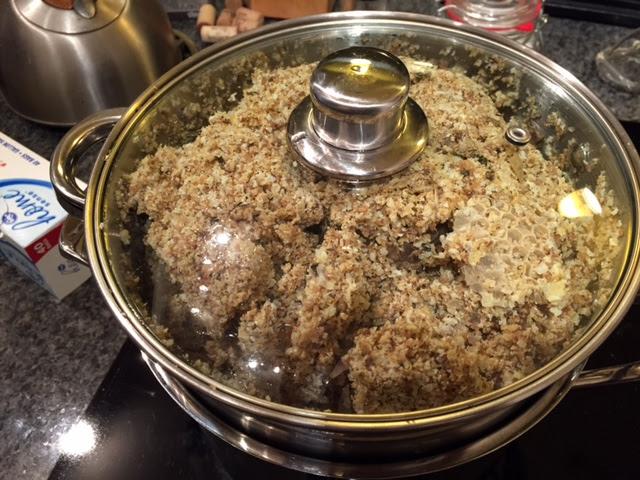
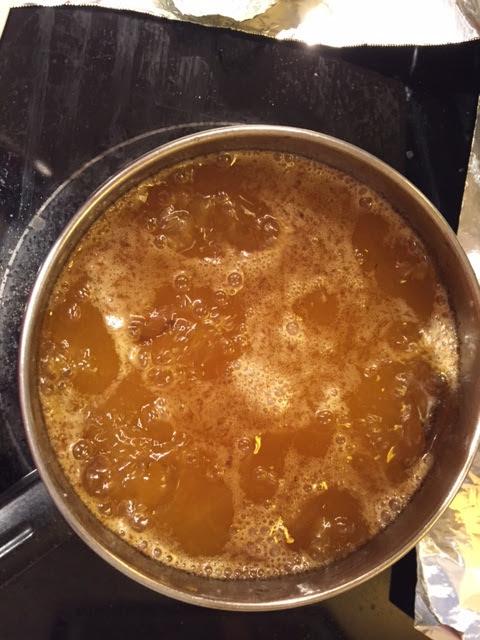
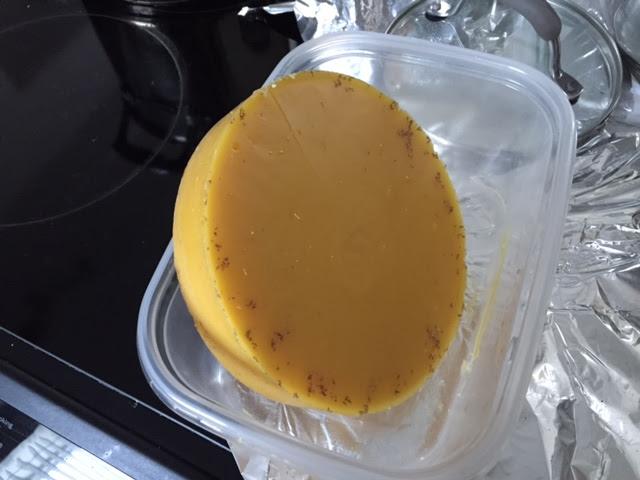

There was more rendering after this photo, but what I have.
Soooo.... I started by cutting some belly trimmings into rectangular pieces.
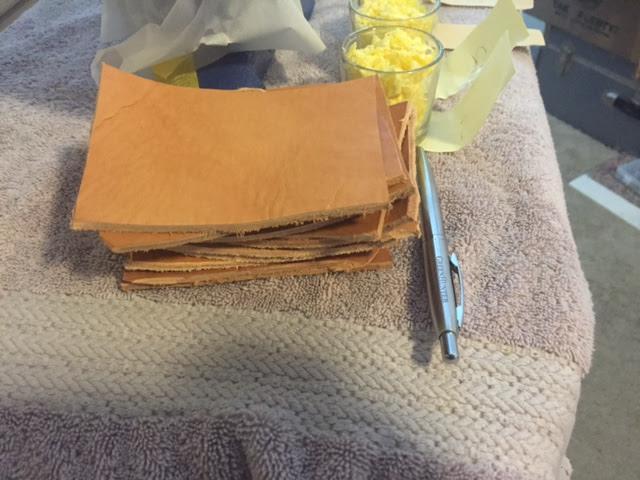
Tinker Tailor for the win! I fine tuned my iron to 145° with the IR gun, used a small anvil as a thermal battery, and parchment paper to avoid ruining the iron or the anvil. The target was between 145° and 155°, erring on the low side for safety. As previously stated, that narrow range is pretty much it where the wax will be liquid and the leather won't be ruined.
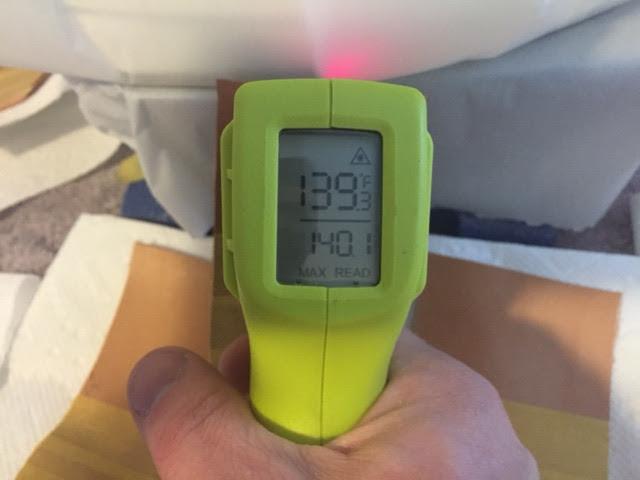
I shaved the beeswax block so that I could weigh out the wax for melting.
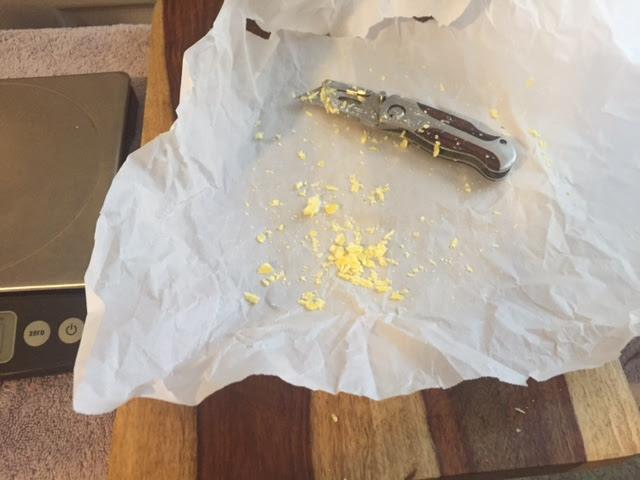
And I weighed samples out for a total of 20 grams each (a little less than 3/4 ounce) between the wax and oil. I went with olive oil since it's the closest I have to neatsfoot (the status quo) by fatty acid content.
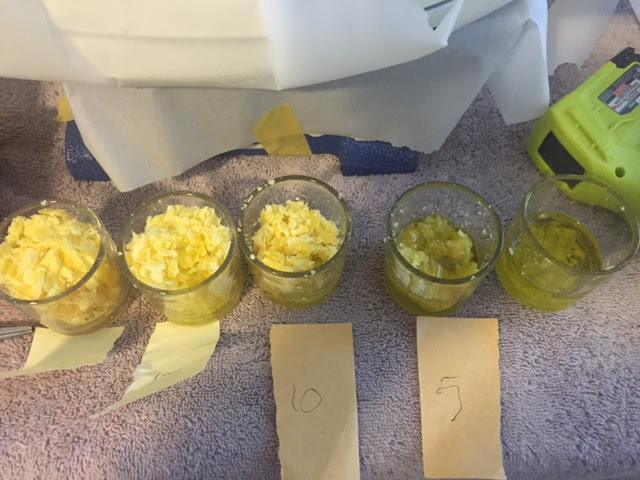
The five samples were neat beeswax, 75/25, 50/50, 25/50, and 15/85 beeswax to oil ratios. The partial sticky notes (somehow I only had one sticky note and the backing pad...) are marked 20, 15, 10, and 5, referring to the grams of beeswax with the unlabeled being 3. The balance was filled with olive oil to a total of 20 grams. Then...
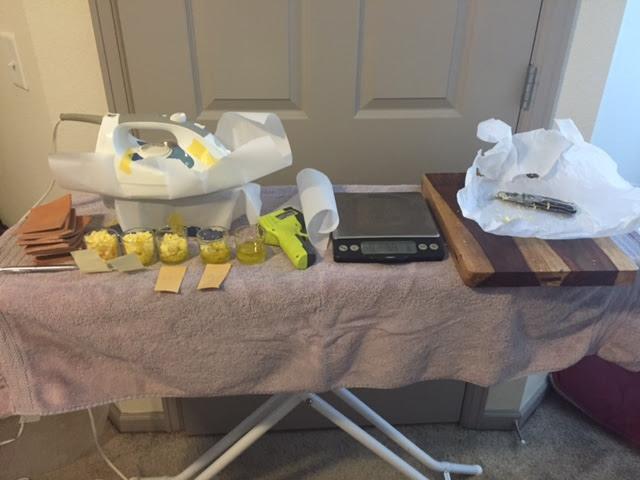
A last minute sanity check, and...
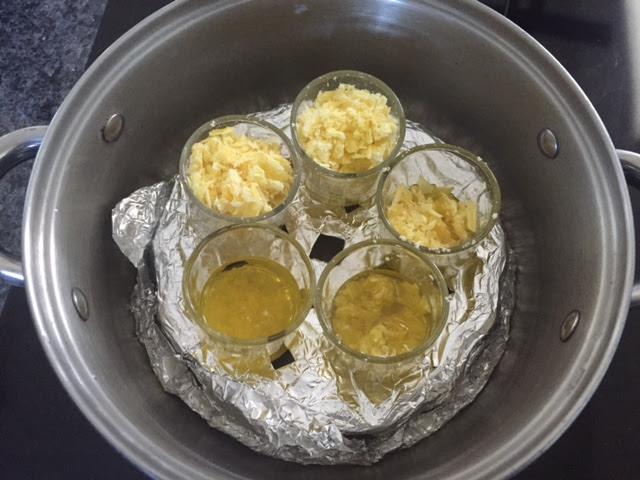
Into the double boiler. This is the smaller of the two pots I bought for this experiment with an aluminum pie tin sliced to form a smaller diameter, perforated, and wrapped in foil so it would stay together under the weight of the glass sample vessels. I think they were glass tea light candle holders, and I got them at the same thrift store I got all the hardware for this experiment. I also found this:
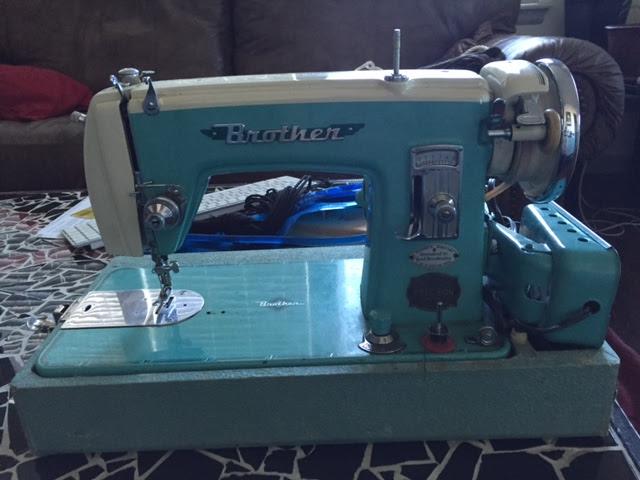
February 1958 Brother portable sewing machine in pretty good, albeit neglected condition. I restored it for my wife for Xmas, and she loved it! Great little thrift store.
Anyway...
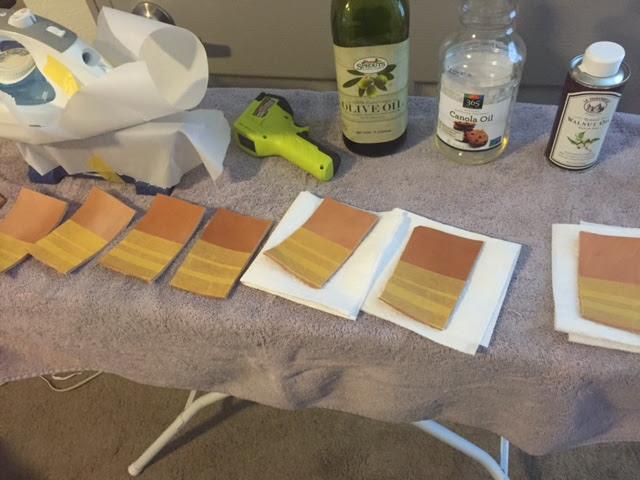
The bellies were pretty seriously old... So much so that I have no idea when I got them, from where, or why. They're all slightly different colors, and all pretty dry, so I taped them off to have a bit more control over the control. Then I got to business.
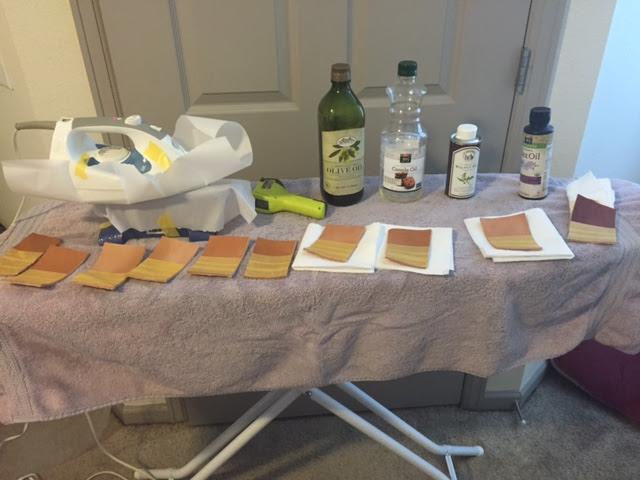
While the wax/oil mixtures were melting, I made go with the oils. The flax oil smells sweet, walnut smells earthy, canola doesn't have much in the way of a smell, and the olive oil smells spicy. I applied multiple coats until it took a little longer for the oil to all be absorbed, and heated the wax-based samples to temp prior to applying the wax oil mixture. This allowed the wax to absorb and not just harden at the surface on contact. I dipped the hot neat wax sample into the hot wax at one end just to see how stiff it got.
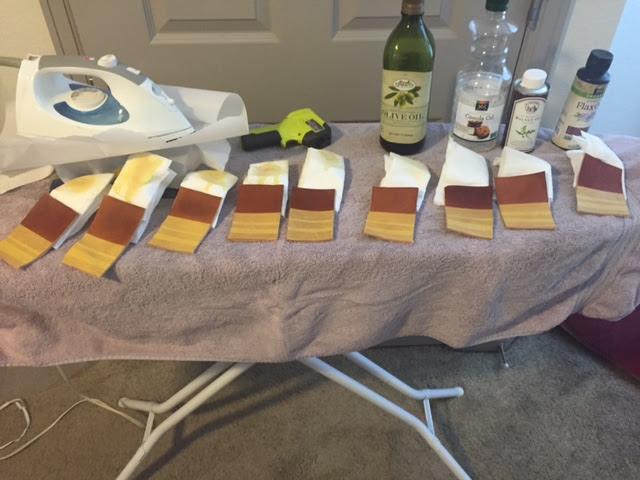
Here's the end result for the day:
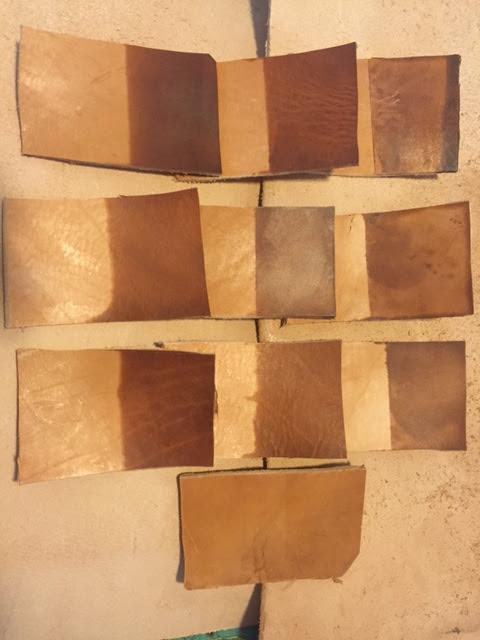
Left to right, top to bottom, that's canola oil, 25% wax, 100% wax, flax, 15% wax, 75% wax, walnut, olive, and 50% wax, and the loner is the control (the organization makes more sense if you rotate it to the right 90°, where you get the waxes in decreasing order followed by the oils with the control to the side). It should be noted that the leather was very dry, and the tape pulled some of the top grain off, lightening the appearance.
The higher wax concentration samples proved difficult to apply, and the result appears pretty splotchy. Application with a good aesthetic result would be either difficult or very time consuming and complicated without significant investment in equipment or risking ruining the leather via heat. Additionally, given the role of the oil in the leather, I don't think ultra high beeswax mixtures will allow the fatty acids to do their lubrication and migration song and dance. That said, it seems the heavier wax mixtures would have a fixative effect on any tooling, and this is desirable... On the other end of the spectrum, it's simply too soon to have any idea how the polymerization of the shorter fatty acid chains will affect the end result.
In terms of color, there are variations in the leather sample pieces muddying things up a bit, but all methods and materials darkened the leather considerably at this point with canola as the surprise stand out. I'm not sure why this is. On the neat wax sample, you can see a strip at the end where I heated it up and just dunked it into the hot wax. The heavy saturation reflects less light than the less saturated area. The splotchiness in the 75% wax sample is a prime example of the difficulty applying higher wax concentrations, while the lesser wax mixtures were considerably easier. Time will tell how these effects last over time.
In addition to the application experience, another significant subjective observation is the smell. The walnut oil sample smelled predominantly of walnut; earthy and not unpleasant, but not especially pleasant either. The olive oil sample smelled essentially like olive oil with no real leather aroma; a bit on the spicy side. The canola oil had no real smell at all. The waxed samples smell to varying degrees of sweet honey to spicy olive oil based on their respective concentrations without much leather smell. The flax oil is sweet on its own, and in the leather has a wonderful smell that stands out above the rest. The leather by itself didn't smell especially strong of anything (it's old), but the flax oil made for a very good leather smell beyond expectation. I don't know why this is, but based on reports of fish oils smelling especially like leather, it makes me wonder exactly what's going on there. They both are notoriously high in omega 3 fatty acids (mid-length polyunsaturated), so maybe there's something going on there... Who knows.

Finally, I allowed the wax mixtures to cool and harden. I expected the neat wax to harden like the rest of the wax, and that the lesser samples would soften considerably to the point that the 15% sample would barely be any more viscous than the oil, but surprisingly they all hardened save the 15% sample.

I stuck my finger in each one, and while the 25% sample gave a tiny bit where some bubbles had formed but was otherwise solid, only the 15% mixture really gave at all. Some water had splashed in from the boiling water, and it squished out from this sample as well. As an aside, it makes good lip balm. Some fiddling with other oils could make for a pretty awesome home made Burt's Bees replacement (the olive oil just lacks the good smell)!
So... Where does that leave us? The 15%, 25%, and to a lesser extent 50% wax mixtures were easy enough to apply as to be viable. Heavier than that was too difficult using these methods. The liquid oils are obviously easy to apply, but time will tell how they do over time. I like the idea of the wax fixing tooling, but have some concern at what it will do over time as the oils break down and subsequently migrate... Or would the wax prevent migration? Additionally, wax is known to stiffen leather, but with enough oil it softens considerably... The question is how this affects things when it's suspended between the leather fibers. How does it affect things as the oil breaks down? The same question can be asked of the polymerization from the shorter fatty acid chains oxidizing. Does this form a barrier that makes subsequent applications of oil difficult or even impossible? The smooth surface that results from the polymer film would make for a good dark color, this would be even more the case when combined with a percentage of wax. The sweet smell of the wax combined with the sweet leather smell from the flax oil and the shine and tooling fixation could be awesome! It could also ultimately shorten the lifespan of the work... It would probably be years before the effects were noticeable, and they may not happen at all, but it is something outside the norm about which I can't find any information.
The next phase is to wait and see what happens over time... Months... Years... I'm not that patient for the immediate projects, so I'll have to decide on something sooner. The next thing I'd like to try is some lighter wax mixtures with other oils. The flax is especially interesting from the perspective of the eventual high gloss polymer finish and dark color it would ultimately result in, but I want to get some longer carbon chains in there too for a bit better lubricity over a longer period of time. That might ultimately mean a multi-phase finish. Maybe a light oiling or two front and back with olive oil, then finish with a heavy application of a 15-25% beeswax/flax oil mixture. That would help the tooling stay crisp, eventually result in a very polished finish, and the sweet smell of the wax and the sweet leather smell will likely be a pretty killer combo. I might investigate another oil or two in there for fun too when I go for the second round... We'll see.
Fingers crossed... Testing in other browsers now...

Tested. Working. Let me know if it plays nice over there... It's something like 1 in the morning over there now, so maybe I'll hear about it in the morning.
-
That's some research! Polymerization isn't bad though. Nor is the amount of time it takes to polymerize. If you WANT the polymerization, and you want it quickly, there are ways to break the triglycerides down faster. The classic example is boiling, which uses energy from heat to break the molecules apart quickly. If you use the food grade stuff, you're relying almost exclusively on time.
For my purposes and intents, this latter scenario was desirable; my philosophical view of leather is that it's a natural material with excellent wear properties that gets better with time and use. The polymerized film at the surface (combine with waxes, etc.) will, in theory (in test), add to the beauty of an item over time. He mentioned in the video that it's an elastic consistency when it cures (this is the polymerized result), and on/in the surface of the leather this seems like a very positive result. It'll protect while adding shine, depth, and color (darkening somewhat). If you're going for a patent leather type finish though, this would definitely not be the way to go.
-
I picked a photo at random, and it appears to be working across devices for me regardless of any session states. Can someone please do a sanity check and confirm whether on not it's visible to anyone else?
Martyn, I'm not familiar with a white square and grayed out stop sign logo. Could you please share your browsing info (OS, application, version, etc.)?
-
Do your homework. Be aware that linseed oil is often BOILED linseed oil, and almost as often adulterated with crap you probably don't want in your leather. Boiled linseed oil is what was traditionally used for making patent leather, but make sure you're not getting boiled linseed oil and various flavors of dinosaur squeezings. Flaxseed oil is what I used. You should be able to find it at any quality grocery store in the specialty oils section (or strangely in the refrigerator of the "juju" section at Whole Foods).
-
Not exactly the response I was hoping for, but here's the results from my first experiments into darkening sans dyes and colorants aside from the above described oils as promised. Ignore the form factor, por favor.
The actual intent here was a final proof of concept for the oiling technique I've been working on. To that end, the results are beyond outstanding... Not only is the leather incredibly supple (moreso than I honestly think I've ever experienced), it feels... Not like the leather couch I'm sitting on (chrome tanned leather that's been conditioned and cared for, but could probably use a touch up), and not wet or oily, but dense... That is honestly the best word I can think of. It has a thermal density to it such that it initially feels a little colder than insulative like leather typically is, bet definitely not expressly wet or waxy or oily either. I've been wearing one of these belts all day (light khaki shorts), and there's no residue; I was a little concerned about this due to past experiences, but I state this more as a means of expressing that it's not really oily per se... It's a very different feel that's difficult to place or compare. Also, and I wasn't going for this either, it has a pronounced pull-up! I always liked this because, when left to its own devices, it give the leather a very unique character as its used over time. I was not shooting for it, but I got it in spades! But that's not the point of this thread...
I set out intending for a slightly darker color, but wasn't exactly sure where I'd end since it wasn't the primary focus. It's an overcast day, which I believe is generally considered ideal for photography, but smartphones fall on the other end of the spectrum. I shot these right in front of an open window for maximum light, and they appear a little darker in person. All the same, the result is a very red-brown mahogany color. I feel like it was probably a shade or two darker while I was still actively treating it, but it's mellowed out a bit as the oil has distributed. As I mentioned above, there's a fair amount of pull-up. I'm pretty sure if I were to buff it, it would darken considerably. Additionally, I could tweak my treatment regiment a bit and probably get it several shades darker based on what oils are used, when, and in what amounts. The next time I'm down near a Tandy, I'll pick up a fresh belly. What I have around here is really old and dry, and I think taints the results a bit.... Even if it doesn't it's something I can and should control for.
It took me a few months, but I think I've finally settled on an oil/wax combination/schedule/method that has got me where I want and more. The next phase in these explorations looks like it'll be adding control over color to the strategy. This experiment will be much easier to design than the last...
-
No problem at all! It's been a fun and rewarding project. I'm glad to know others are benefiting as well.
-
In the current phase of my experimentation, I'm attempting to see how dark I can get vegetable tanned leather with nothing but carefully selected natural, organic, plant-based oils and sunshine. So far, I've managed to get a piece far darker than I thought was possible without dyes or lots of time, and I'm only about halfway through the intended process. I was wondering if people could share photos of their darkest results achieved without any dyes. As soon as I get through the current process, I'll share photos of my results here as well.

Thread Strength Comparison Test
in Sewing Leather
Posted · Report reply
I've also done some UV exposure testing on vegetable tanned leather, but not thread. The testing is all done (nearly 60 full days' worth), I just haven't done anything with the samples yet (they're all packed into the same spare room for forgetting purposes). I'm not sure exactly how you would do a realistic abrasion test for thread. It doesn't seem as simple as just taking sandpaper to it... There is an industrial standard, so someone has already figured it out, but I've not looked into it at all. Linen was the clear natural fiber winner for strength, which I know won't come as much of a surprise to some, but now there's actual context and some idea of relativity. This is pure conjecture, and as demonstrated above, is apparently not my strong suit with this sort of thing, but I think since linen thread is used in shoes, it's probably pretty decent on the abrasion side of things. I think I read that it has good uv, abrasion, and mildew (for another testable element) resistant properties, but that may or may not have involved waxing...